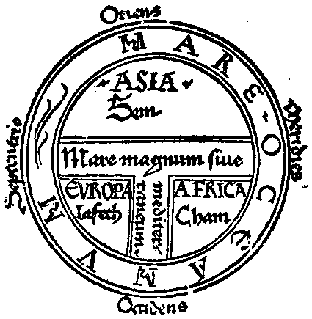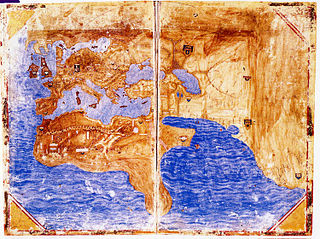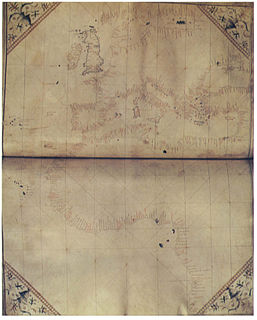
Ahmet Muhiddin Piri, better known as Piri Reis, was an Ottoman admiral, navigator, geographer and cartographer. He is primarily known today for his maps and charts collected in his Kitab-ı Bahriye, a book that contains detailed information on early navigational techniques as well as relatively accurate charts for their time, describing the important ports and cities of the Mediterranean Sea.

Visconte Maggiolo, also spelled Maiollo and Maiolo, was a Genoese cartographer.

Francis Douce was a British antiquary and museum curator.

Albertinus de Virga was a 15th-century Venetian cartographer.

Abraham Cresques, whose real name was Cresques (son of) Abraham, was a 14th-century Jewish cartographer from Palma, Majorca. In collaboration with his son, Jehuda Cresques, Cresques is credited with the authorship of the celebrated Catalan Atlas of 1375.

Portolan charts are nautical charts, first made in the 13th century in the Mediterranean basin and later expanded to include other regions, which have been noted for their high cartographic accuracy. The word portolan comes from the Italian portulano, meaning "related to ports or harbors", and which since at least the 17th century designates "a collection of sailing directions".

"Majorcan cartographic school" is the term coined by historians to refer to the collection of predominantly Jewish cartographers, cosmographers and navigational instrument-makers and some Christian associates that flourished in Majorca in the 13th, 14th and 15th centuries until the expulsion of the Jews. The label is usually inclusive of those who worked in Catalonia. The Majorcan school is frequently contrasted with the contemporary Italian cartography school.

Pietro Vesconte was a Genoese cartographer and geographer. A pioneer of the field of the portolan chart, he influenced Italian and Catalan mapmaking throughout the fourteenth and fifteenth centuries. He appears to have been the first professional mapmaker to sign and date his works regularly.

The Map Collectors' Circle was founded in London in April 1963 by Ronald Vere Tooley with a stated aim of "stimulating interest in and publish material on early printed maps, atlases, cartographers, etc." Between 1963 and 1975, it set about fulfilling its second mandate with a series of 110 monographs related to the field of historical cartography which remain of interest to cartographers for their breadth. An index to the series has been created by the Bodleian Library Map Section.

Lopo Homem was a 16th-century Portuguese cartographer and cosmographer based in Lisbon and best known for his work on the Miller Atlas.
Gabriel de Vallseca, also referred to as Gabriel de Valseca and Gabriel de Valsequa and Gabriel de Vallsecha was an Aragonese cartographer of Jewish descent connected to the Majorcan cartographic school. His most notable map is the portolan of 1439, containing the first depiction of the recently discovered Azores islands.
Domenico and Francesco Pizzigano, known as the Pizzigani brothers, were 14th-century Venetian cartographers. Their surname is sometimes given as Pizigano in older sources.
The Weimar map is an anonymous 15th-century Italian portolan chart, held by the Grand Ducal Library of Weimar. Although frequently dated as 1424, most historians believe it was probably composed a half century later. The author is unknown, although said to be a member of the Freducci family of cartographers of Ancona, most probably Conte di Ottomano Freducci. Faint and fragile, the Weimar map is rarely photographed and has been hard to decipher.

The Medici-Laurentian Atlas, also known simply as the Medici Atlas, is an anonymous 14th-century set of maps, probably composed by a Genoese cartographer and explicitly dated 1351, although most historians believe it was composed, or at least retouched, later. The atlas is currently held by the Biblioteca Medicea Laurenziana in Florence, Italy.

Guillem Soler, sometimes given as Guillelmus Soleri, Guillermo Soler and Guglielmo Soleri, was a Majorcan cartographer of the 14th century.
The Tammar Luxoro Atlas, or Atlante Luxoro, is an anonymous collection of Italian portolan charts from the early 15th century, currently held at the Biblioteca Civica Berio in Genoa, Italy. The author is unknown, although believed to have been made by Francesco de Cesanis of Venice.
The Corbitis Atlas is a late 14th-century atlas of four portolan charts, composed by an anonymous Venetian cartographer, and currently held by the Biblioteca Nazionale Marciana in Venice, Italy.
The Pinelli–Walckenaer Atlas is a late 14th-century atlas of portolan charts, explicitly dated 1384, primarily composed by an anonymous Venetian cartographer, and held by the British Library.

The Cornaro Atlas is an extensive Venetian collection of nautical charts and tracts, currently held by the British Library.

The Liber Secretorum Fidelium Crucis is a Latin work by Marino Sanuto the Elder intended to inspire a revival of the Crusades. It has also been named as Historia Hierosolymitana and Liber de expeditione Terrae Sanctae, and Opus Terrae Sanctae, the last being perhaps the proper title of the whole treatise as completed in three parts or "books".















